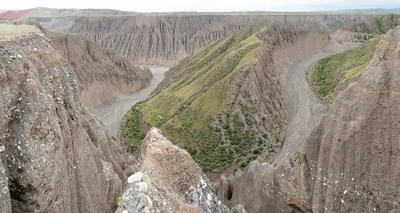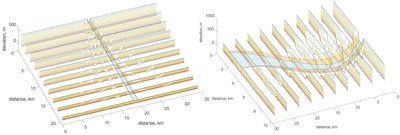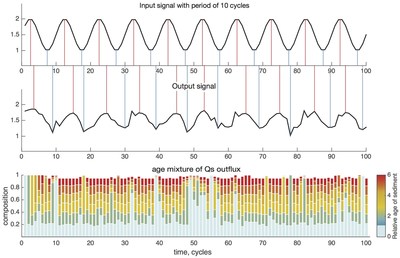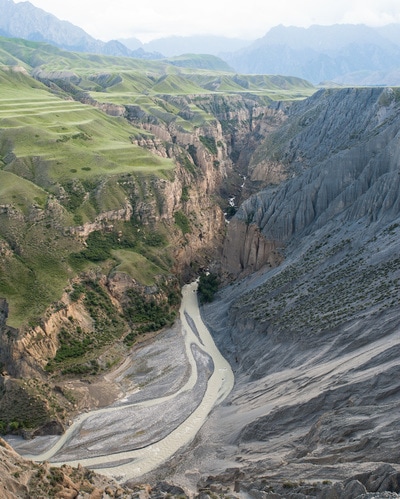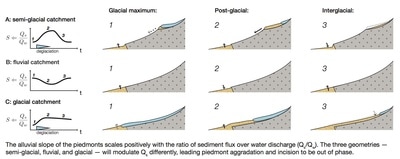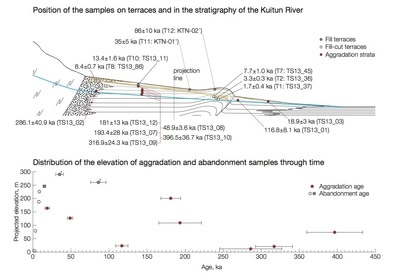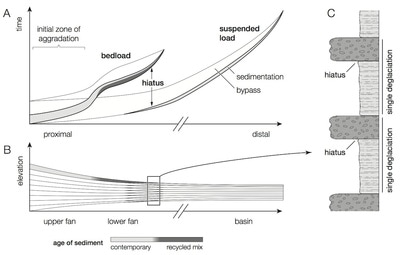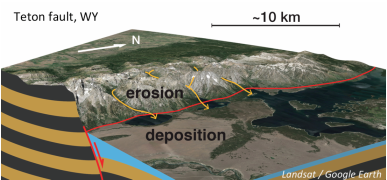tectonic geomorphology of subduction margins
With Lucile Bruhat (ENS Paris) and Noah Finnegan (UC Santa Cruz)
In subduction zones, onshore geodesy provides the main data used to map seismic locking on the plate interface. We propose a new offshore control by establishing the co-location of the shelf break and the locking depth based on the Cascadia subduction. The erosive shelf of a subduction margin results from continuous uplift and active wave erosion. The long-term uplift is driven by 1) the non-recoverable fraction of interseismic deformation and 2) continental uplift (e.g. isostasy). We combine a wave erosion model with an elastic deformation model to show how the hinge line that marks the transition from interseismic subsidence to uplift pins the location of the shelf break. A global compilation of subduction zones with well resolved locking depths confirms our model with shelf breaks lying much closer to the locking depth than coastlines. Subduction margin morphology integrates hundreds of seismic cycles and informs seismic coupling stability through time.
Article in revision
Article in revision
An erosive continental shelf requires wave-base erosion and rock uplift. These conditions are met landward of the uplift hinge line set by the combined patterns of interseismic and continental uplift (top). The shelf break is anchored at the hinge line, and the shelf can grow landward by coastal retreat (bottom). The interseismic deformation is controlled by the pattern of locked, transitional, and creeping segments of the megathrust.
probabilistic Model for sediment mixing by aggradation-incision cycles on alluvial piedmonts
One of many aspects controlling the poorly-constrained silent transport timescale is the recycling of old sediments deposits along the sediment routing system. When alluvial rivers incise their bed, they remobilize old material and add it to the modern sediment flux. If the age of the river substrate is significant, the recycled ancient sediments can impact the geochemical signature of the modern flux by the addition of old or aged signals.
We seek here to constrain how much recycling is to be expected from different scenarios where river are cyclically aggrading and incising (case example: an long-term aggradational alluvial fan with a high-frequency, climatically forced overprint of river aggradation and incision). We build a numerical framework doubled by an analytical solution to predict the probability density function of ages recycled across an alluvial zone and present in the modern sediment flux.
Article in prep.
We seek here to constrain how much recycling is to be expected from different scenarios where river are cyclically aggrading and incising (case example: an long-term aggradational alluvial fan with a high-frequency, climatically forced overprint of river aggradation and incision). We build a numerical framework doubled by an analytical solution to predict the probability density function of ages recycled across an alluvial zone and present in the modern sediment flux.
Article in prep.
repeated cycles of aggradation-incision during glacial and interglacial periods on the tian shan piedmont
with Jean-Philippe Avouac (Caltech), Nathan D. Brown (UCLA), Sebastian F. M. Breitenbach (RUB, Bochum) and others.
We study successions of Pleistocene aggradatio-incision cycles in the northern alluvial piedmont of the Chinese Tian Shan. Under the influence of glacial cycles driven by changes in temperature and in moisture delivery by the Westerlies, the north piedmont has undergone repeated phases of deep fluvial incision followed by important aggradation. The piedmont deeply incised and aggraded many times per 100 kyr over the last 0.5 Myrs.
Aggradation is driven by increased sediment flux as glaciers retreat under warmer and wetter climate. The increased water discharge of that period flushed onto the piedmont glacial sediment that accumulated in the high range during the relatively dry previous glacial period. The rivers incised again as the input sediment flux decreased after evacuation of the bulk of the high range sediments.
The precise timing of incision does not reflect climate forcing but the time it takes to evacuate sediments flushed out during deglaciation.
A significant fraction of sediments evacuated from the high range is temporarily deposited on the piedmont before a later incision phase can deliver it to the basin. The arrival of the gravel front into the proximal basin is delayed relative to the fine-grained load and both are separated by a hiatus.
Malatesta L. C., Avouac J.-P., Brown N. D., Breitenbach S. F. M., Pan J., Chevalier M.-L., Rhodes E., Saint-Carlier D., Zhang W., Charreau J., Lavé J., Blard P.-H., Repeated cycles of piedmont aggradation and incision driven by climate variability during glacial periods in the Tian Shan, in review at Basin Research.
Malatesta L. C. & Avouac J.-P., Contrasted river incision in north and south Tian Shan piedmonts due to different glacial overprint of high range topography, in review at Geology.
Aggradation is driven by increased sediment flux as glaciers retreat under warmer and wetter climate. The increased water discharge of that period flushed onto the piedmont glacial sediment that accumulated in the high range during the relatively dry previous glacial period. The rivers incised again as the input sediment flux decreased after evacuation of the bulk of the high range sediments.
The precise timing of incision does not reflect climate forcing but the time it takes to evacuate sediments flushed out during deglaciation.
A significant fraction of sediments evacuated from the high range is temporarily deposited on the piedmont before a later incision phase can deliver it to the basin. The arrival of the gravel front into the proximal basin is delayed relative to the fine-grained load and both are separated by a hiatus.
Malatesta L. C., Avouac J.-P., Brown N. D., Breitenbach S. F. M., Pan J., Chevalier M.-L., Rhodes E., Saint-Carlier D., Zhang W., Charreau J., Lavé J., Blard P.-H., Repeated cycles of piedmont aggradation and incision driven by climate variability during glacial periods in the Tian Shan, in review at Basin Research.
Malatesta L. C. & Avouac J.-P., Contrasted river incision in north and south Tian Shan piedmonts due to different glacial overprint of high range topography, in review at Geology.
tectonics-surface processes coupling in extensional domains
|
The Earth surface is the upper boundary condition of the crust and as such redistribution of mass on that surface — erosion and sedimentation — affects the underlying tectonic dynamics. Here we investigate how the intensity of erosion can sustain long-lived normal faults by unloading the rising footwall. We map different lifetimes of normal faults, from short-slip mid-Ocean ridges to metamorphic core complexes, as a function of crustal thickness and erosional efficiency. Please find more details about that project on the website of Jean-Arthur Olive.
|
terrace record and autogenic entrenchment
- Feedbacks between valley wall height and channel sediment transport capacity influence vertical incision
- The inversion of a fill-cut terrace record for paleohydraulic conditions should take lateral feedbacks into consideration
- Autogenic processes due to lateral feedbacks in alluvial rivers can force accelerated incision without external forcings
waterfalls created by intermittent shielding of active tectonic scarps by alluvial fans
with Michael P. Lamb
The intermittent burial of active fault scarps by alluvial fans allows the accumulation of tectonic slip under a protective sedimentary shield. We show that this mechanism can account for otherwise unexplained waterfalls. As a consequence, accumulated tectonic offset is released in the catchment on a beat set by climate variations. The resulting knickpoints are larger than co-seismic throw, potentially increasing the catchment reactivity by migrating faster than their smaller counterparts. Our field area spans several mountain ranges in the Death Valley region, California.
Malatesta L. C. & Lamb M. P., Formation of waterfalls by intermittent burial of active faults, in review at GSA Bulletin
Malatesta L. C. & Lamb M. P., Formation of waterfalls by intermittent burial of active faults, in review at GSA Bulletin



